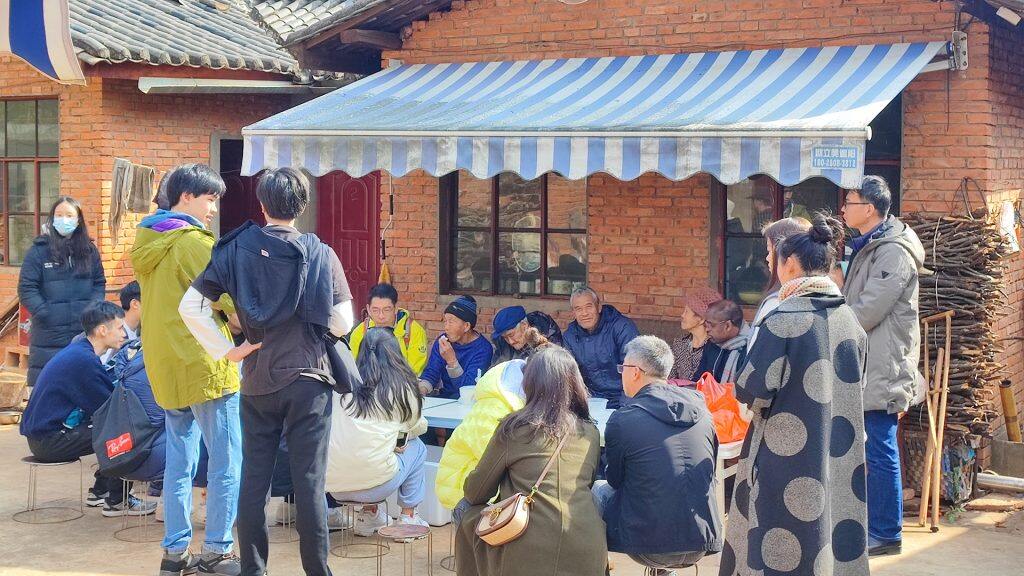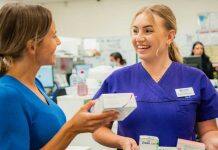

Traversing a towering mountain in China’s southwestern Yunnan province, witnessing the spirit of collaboration behind its local healthcare services and exploring the intricacies of Traditional Chinese Medicine (TCM) – these were just some of the experiences that enabled a group of 17 NUS students to discover the region’s healthcare landscape as part of a 12-day journey.
Organised by the Yong Loo Lin School of Medicine under the NUS Study Trips for Engagement and EnRichment (STEER) programme, the trip was one of the experiential learning opportunities offered under NUS Medicine’s Health and Humanity Pathway Programmes, which aims to equip students with the knowledge, skills and heart to serve vulnerable communities.
Two NUS Nursing undergraduates from the Career Conversion Programme for Registered Nurses (CCP-RN) who joined the trip – Year 1 students Oh Shao Yu, who made the switch to healthcare following a 10-year career in the banking industry, and Ong Yu Chan, who has spent seven years in the community services sector – pen their reflections on their learning journey.
Along with a multidisciplinary group of students from Medicine, Pharmacy, Social Work and Business, we travelled to Yunnan, China from 27 December 2023 to 7 January 2024 for the STEER Health and Humanity study trip led by Associate Professor Tan Lai Yong, a Fellow at the College of Alice and Peter Tan, and Dr Blanche Lim, Co-Lead of Optometry Education at NUS Medicine’s Centre for Innovation and Precision Eye Health.
With visits to the southern Xishuangbanna prefecture, the province’s capital Kunming and the northwestern city of Lijiang, the trip explored the healthcare challenges facing the local communities, while exposing us to life in the rural villages and the rich ethnic diversity of Yunnan, home to the Dai, Akha and Naxi people. During our trip, we had the privilege of visiting various healthcare facilities to gain an in-depth insight into primary care delivery, including a county hospital, a rural village clinic and the main Dai Traditional Medicine Hospital in Xishuangbanna.


Being introduced to these different healthcare systems that are based on different philosophies and cultures opened our eyes to the many ways of providing care. At a regional hospital that incorporates Western and TCM practices, we learned how TCM focuses on rehabilitation, supportive treatment and self-healing in its treatment methods and emphasises a holistic approach tailored to the needs of each patient. From these visits, we gained insights into how traditional medicine places importance on preventive healthcare and nutrition, and that culture is an important factor in shaping an individual’s health choices. Through interactions with healthcare workers from the various entities, we came to understand how each of these different healthcare organisations forms an integral part of the entire ecosystem, with each having a role to play in serving the needs of the population.
Our visit to a remote leprosy rehabilitation village offered a valuable lesson on how the perception of a community towards a disease can have a profound impact on patients and their families. Caused by a type of bacteria known as Mycobacterium leprae, leprosy mainly affects the skin, eyes, nerves and mucous membranes. It is spread through prolonged and close contact with the nose and mouth droplets of untreated individuals and its symptoms include skin lesions and muscle weakness. Curable with early treatment, it was once highly stigmatised due to misconceptions about the disease. Established between the 1950s and 1960s, the village’s small community has since dwindled to just six residents, with many having passed away over the years. These individuals not only suffered from the disease’s physical toll but also endured the stigma and misinformation that came with it. Meeting these real-life warriors who remained independent and resilient despite their circumstances was an honour, prompting us to think more deeply about how community rehabilitation affects patients, their social connectedness and mental well-being. As future healthcare providers, it also inspired us to reflect on our attitudes and mindset to ensure that we treat everyone as a person rather than a patient and to work actively to stem misinformation.


We also visited Jiaozi Snow Mountain, located about 150 km from Kunming City, a mountain named after its peaks which resemble a sedan chair when seen from far. Like most visitors, we took the cable car up to the scenic spot at 3,147 m above sea level. From there, we crossed the wooden boardwalk and up the stairs to the lookout points. These boardwalks make the trek easier and prevent visitors from damaging the ecosystem. The frozen waterfalls offered beautiful photo opportunities, so we took our time to ascend. In doing so, we realised that moving slowly helped us to prevent altitude sickness. However, the high altitude coupled with the low temperature, made this a challenging experience, especially for some of our teammates. Through this experience, we were able to understand first-hand the realities of the risks posed by altitude sickness beyond the prior research we had done about the condition and its signs and symptoms.


On a broader level, we also gained insights into how rapidly China is developing and its impact on the environment and the economy. Through our interactions with local village doctors, we learnt how government policy changes translate to the provision of healthcare services on the ground and the challenges that arise when these changes are introduced to the healthcare ecosystem. These village doctors are essential to the community healthcare system, aiding in the control and management of infectious and chronic diseases as they work very closely with the villagers and have a deep understanding of the villagers’ family, social and financial situations. Seeing this first-hand helped us understand the need for community-based care in Singapore and inspired us to think of how we can contribute to this sector in the future.
Through interactions with teachers from a school for children with special needs, we learned that there was a growing recognition of the importance of early intervention in helping the children to learn and eventually integrate into the community. As some of the students lived in villages far from the school, they were provided with boarding facilities given that it was not financially nor logistically feasible for the students to travel to school daily. That convenience, however, came with the loss of familial support. Contrasting that with Singapore and other places, we gained an appreciation for the vital role that families and communities play in participating in the growth and learning process of children who require specialised interventions – a factor that is likely to be beneficial for their adaptation and integration in the long run.
With a plethora of opportunities to deepen our understanding of preventive healthcare, healthcare provisions and its outcomes across different dimensions, STEER has been an enriching programme that enables nursing students like us to contemplate how we will approach our future role in the healthcare sector.
All in all, it was a trip that broadened our horizons. It enabled us to interact with other students from various faculties and allowed us to understand their different viewpoints. As mid-career professionals making the switch to a new industry, this was of even greater importance as we will be entering the healthcare workforce together with this generation of students. The trip enabled us to gain an insight into the aspirations and expectations of our younger teammates, helping us to visualise ways we can work together in the future, and we look forward to our continuing friendships.








































